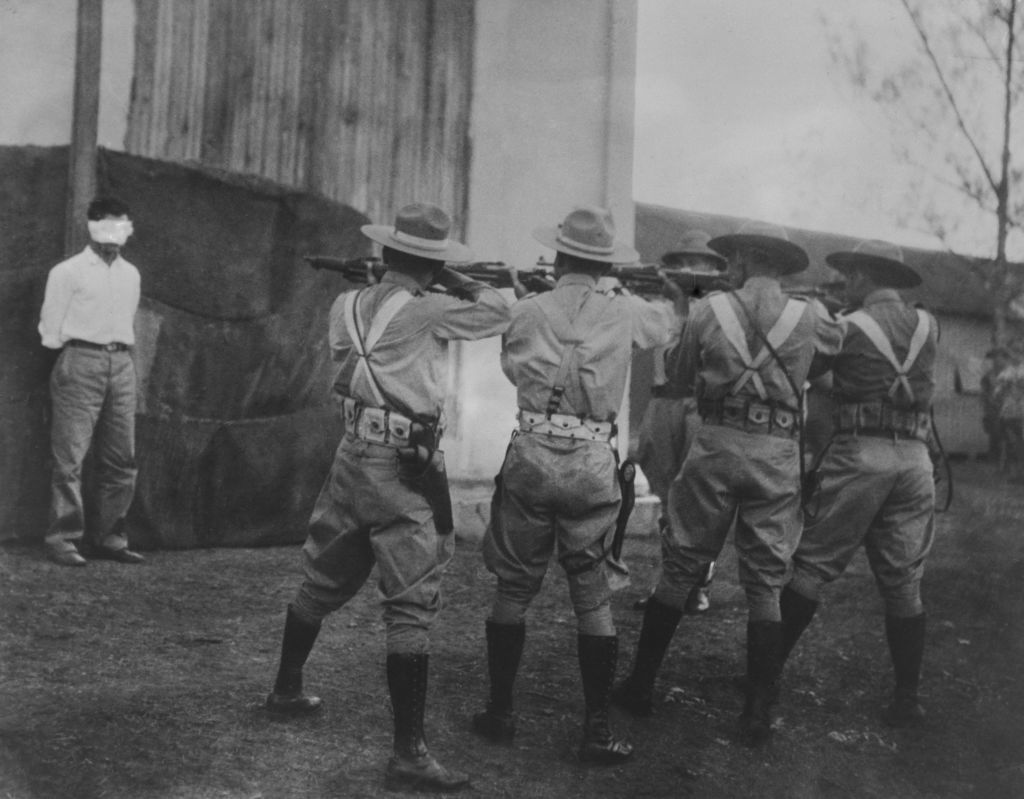The Idaho Senate approved a bill Monday reinstating the firing squad as a backup option for executions when lethal injection drugs are unavailable.
Like South Carolina—which approved electrocution and the firing squad as options in 2021 before being stopped by a state judge last year—Idaho has never actually executed anyone by firing squad, even though it kept the option on the books as a backup until 2009. The new law still needs the signature of Gov. Brad Little to become law, but it passed the legislature with a veto-proof majority.
Although it has historically been one of the most common methods of execution in the world, in the United States the firing squad has rarely been used outside the military: An expert witness in the South Carolina case found only 34 instances nationwide since 1900.
What prompted Idaho’s legislation?
The main reason is that lethal injection drugs are increasingly hard to come by. First approved by Oklahoma in 1977 and used by Texas in 1982, lethal injection is the primary method of execution for all states with a death penalty, as well as the federal government, according to the Death Penalty Information Center. In theory, that’s because it’s more humane than other methods and not as susceptible to constitutional challenges related to the Eighth Amendment’s prohibition of cruel and unusual punishment.
But moral concerns and litigation surrounding lethal injection have persisted. Almost as soon as the 2008 Supreme Court case Baze v. Rees upheld the constitutionality of Kentucky’s three-drug regimen, similar to most death penalty states, the first of the three drugs—sodium thiopental, a general anesthetic—became increasingly difficult for those states to obtain. In 2009, technical problems forced Hospira, the only American manufacturer of sodium thiopental, to close the factory that produced it. In 2011, the company decided to stop making the drug altogether, and European companies stopped exporting it.
A mix of business, regulatory, and moral decisions by pharmaceutical companies has continued to make drugs for lethal injection difficult to access, contributing to what Justice Samuel Alito described as “a guerrilla war against the death penalty” in oral arguments for Glossip v. Gross (2015). In that case, Oklahoma death row inmates argued that the state’s replacement of sodium thiopental with off-label midazolam violated the Eighth Amendment, ultimately losing 5-4.
In 2016, Pfizer, the last FDA-approved manufacturer of drugs that could be used for lethal injection, followed in the footsteps of more than 20 other companies by withholding its drugs from use in executions. The lack of approved options has led states to rely on non-FDA-approved compounding pharmacies. Several have implemented secrecy statutes that shield the identities of their suppliers and have engaged in cash transactions, raising concerns about transparency.
All of this has made lethal injection “more chaotic than ever,” said Deborah Denno, a criminologist at Fordham Law School. Even before the Baze Supreme Court case, evidence suggested that botched executions by lethal injection were a problem—and if anything, it’s gotten worse. Between 1890 and 2010, 7 percent of executions by lethal injection were botched, according to research by Amherst College professor Austin Sarat. In 2022, DPIC reported, that number was 35 percent.
In Tennessee, several death row inmates have even chosen electrocution over lethal injection in recent years due to fears of the horrific pain they would experience if their injection was botched—and electrocution is not known for being gentle and humane.
In the midst of the chaos, the firing squad starts to look like a more appealing option.
Are firing squads more humane?
“The reason we use firing squads in wars is because it works,” Denno said. “It kills people right away.”
Utah is the only state to have used a firing squad for civilian executions since 1900, most recently in 2010 (except for Nevada, where in 1913 a prisoner was killed with a firing squad machine).
Under Utah’s protocols, a team of five trained marksmen—one of whom has a rifle loaded with blanks—fires a single volley at a target placed over the inmate’s heart, followed by a second volley if the inmate is still alive. No firing squad executions were botched between 1890 and 2010 according to Sarat’s research, though some dispute that claim. South Carolina’s protocol is similar, and Oklahoma and Mississippi are the only other states where it is legal. In Idaho, the Department of Correction estimates that it will cost $750,000 to build or retrofit a death chamber suitable for firing squad executions.
Although the South Carolina judge ruled last year that the firing squad is “cruel, unusual, and corporal” in violation of the state constitution, the method received favorable commentary from Justice Sonia Sotomayor in her dissenting opinion in Glossip: “At least from a condemned inmate’s perspective … such visible yet relatively painless violence may be vastly preferable to an excruciatingly painful death hidden behind a veneer of medication.”
But returning to the firing squad as a legal fallback doesn’t necessarily mean states will actually start using it.
“Because it’s a more sure killing device, because it’s actually been used to kill people, the irony is it has bad press because of that,” Denno said. “People want to be assuaged that the way that we’re executing somebody is humane, that they’re just falling asleep, that it’s a medical procedure, that it’s modern, that we are a civilized society, and that we’ve progressed beyond shooting people by firing squad.”
But the track record of botched lethal injections challenges those assumptions. “The methods that we’ve tried to come up with to appease people have been more brutal than what we’ve ever had historically,” Denno said. “Nobody wants to face that.”






Please note that we at The Dispatch hold ourselves, our work, and our commenters to a higher standard than other places on the internet. We welcome comments that foster genuine debate or discussion—including comments critical of us or our work—but responses that include ad hominem attacks on fellow Dispatch members or are intended to stoke fear and anger may be moderated.
With your membership, you only have the ability to comment on The Morning Dispatch articles. Consider upgrading to join the conversation everywhere.